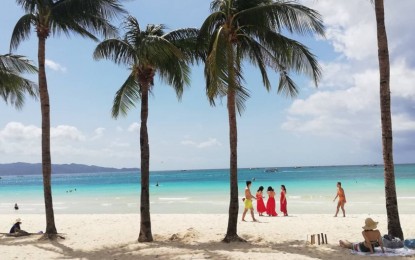
Tourists, mostly foreigners, enjoy the sun and beach in the famed Boracay Island in the Philippines. (File photo)
MANILA --The Department of Tourism (DOT) aims to intensify its marketing efforts in other countries to offset the impact of 2019-novel coronavirus (2019-nCoV) on Philippines’ tourism industry in line with the goal on reaching the targeted 9.2 million foreign tourists by end of 2020 despite the travel ban on visitors from nCoV-hit areas.
“The DOT will embark on a more aggressive marketing and promotions campaign in other major geographic source markets. Our campaign will be amplified through various digital and social media platforms,” DOT Undersecretary Benito Bengzon, Jr. told the Philippine News Agency (PNA) on Tuesday.
Several countries, including the Philippines, have imposed various levels of travel restriction to and from China, the epicenter of the outbreak.
Although China is the fastest-growing market, it only comes second to South Korea, which remains the top tourist market of the Philippines with 1,785,357 visitors for the first 11 months of 2019.
The two are followed by the United States, Japan, Taiwan, Australia, Canada, the United Kingdom, Singapore, Malaysia, India, and Germany.
Aside from attracting international travelers not covered by the travel restriction, Bengzon said the DOT will also develop more “attractive domestic tour packages” to encourage locals to travel around the country.
“We will also work closely with the private sector in developing attractive domestic tour packages to encourage Filipinos to travel around the country. We want to ensure that the tourism livelihood especially at the community level is not disrupted,” he said.
According to London-based World Travel & Tourism Council (WTTC), the health crisis in China could have a damaging and lasting economic impact on the global travel and tourism sector unless lessons are learned from previous viral epidemics.
Analysis of previous major viral epidemics by the travel and tourism body showed that the average recovery time for visitor numbers to a destination was 19 months, but with the right response and management could recover in as little as 10 months.
The worldwide economic impact of H1N1 was estimated at up to USD55 billion, according to WTTC. A similar economic impact affected China, Hong Kong, Singapore and Canada after the 2003 SARS outbreak, damaging the global travel and tourism sector by between USD30 and USD50 billion, it said.
WTTC President and Chief Executive Officer Gloria Guevara said economic losses from such health issues, like the current 2019-nCoV spread, can be avoided “through the effective use of crisis preparedness and management procedures, as well as through managing public panic and making rational decisions through travel”.
Guevara is the former tourism minister of Mexico who was closely involved in 2010 with the aftermath and recovery of the Mexican outbreak of the H1N1 influenza virus which led to scores of fatalities.
"The most effective management of a crisis requires rapid activation of effective emergency plans, and we can see that in the early days of this outbreak, the Chinese government has acted rapidly," she said in a statement dated January 24.
Guevara said quick, accurate and transparent communication, however, is also crucial in order to contain panic and mitigate negative economic losses.
“Containing the spread of unnecessary panic is as important as stopping the virus itself," she added. (PNA)
